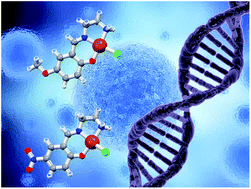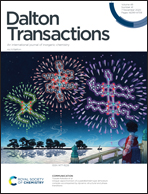From solid state to in vitro anticancer activity of copper(ii) compounds with electronically-modulated NNO Schiff base ligands†
Abstract
The copper(II) complexes of general formula [Cu(GL)(Cl)] (1–3, G = OMe, H and NO2, respectively), bearing tridentate Schiff base ligands (GL−) and a chloride as a fourth labile one, are here reported. The Schiff bases derive from the monocondensation of ethylenediamine and substituted salicylaldehyde, where the electronic properties are modulated by the releasing or withdrawing power of the G group. The compounds were structurally characterized through single crystal Synchrotron X-ray diffraction experiments in the solid state, revealing that 1 (OMe) and 2 (H) adopt a dimeric assembly [Cu(μ-Cl)(GL)]2 through apical interaction of the chloride ions of two monomeric units, while 3 embraces a 1D polymeric chain structure [Cu(μ-Cl)(NO2L)]n with a similar bridging fashion, all supported by extended intramolecular or intrachain hydrogen bonds. The redox properties of the complexes were also studied by cyclic voltammetry with no marked effect of the substituent on the potential of the CuII/CuI redox system. UV/Vis spectroscopic studies in mimicked physiological conditions highlighted the intactness and stability of the coordinated NNO tridentate ligand in 1–3 and the lability of the coordinated chloride ion with the formation of the aquo-complexes [Cu(GL)(H2O)]+ in aqueous solution, as confirmed by conductance measurements with a 1 : 1 electrolyte molar conductivity. In vitro tests on cell viability were conducted on malignant cell lines typical for their poor prognosis and curability, revealing time-dependent and differential cytotoxicity given by the substituent G. All compounds were capable of formation of intracellular reactive oxygen species and DNA intercalation, acting as nuclease and producing double-strand DNA breaks. This is especially effective for 3 (NO2), which revealed the highest anticancer activity against malignant triple-negative breast cancer MDA-MB-231 cells, with a two-to-four-fold cytotoxicity enhancement with respect to 1 (OMe) and 2 (H), and, most important, substantial differentiation of cytotoxicity with respect to healthy endothelial HUVEC cell line.



 Please wait while we load your content...
Please wait while we load your content...